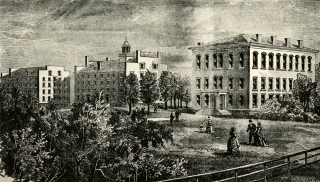gallery with his classmates he grew so absorbed in Dr. Brooks’s sermons as completely to lose consciousness of his surroundings.
The missionary spirit which had vitalized the activities of the Society for Inquiry and the Eastern and Western Associations waned after 1850. Furthermore, the Removal Controversy had carried off many of the leaders whose ardent interest in the objectives of the organizations, students of succeeding generations did not share. Most noteworthy of the Eastern Association’s members was Jonathan Goble, Class of 1859, a Marine from Perry’s expedition to Japan, who returned to the Empire in 1860 as a missionary and subsequently achieved fame for translating the Gospel of Matthew into Japanese; he is also credited with the construction of the first jinrikisha. By 1860 both the Eastern and Western Associations had ceased to exist. The Society for Inquiry, which absorbed their activities, carried on into the 1890’s.
More closely conforming to contemporary interests was the Theological Lyceum which the Seminary students and faculty organized in 1854 to promote the “intellectual, moral, and religious improvement of its members.”
Topics for essays and discussions at its meetings included: Christianity and the Crimean War, spiritualism, freemasonry, and the propriety of a minister’s resorting “to firearms or deadly weapons in defense of political rights.”
The Lyceum became practically moribund in the 1860’s, but did not expire until 1871.
For many undergraduates the question of secret societies was much more absorbing than participation in those of a religious character. Despite faculty action suppressing fraternities in the 1840’s and a stipulation in the Laws of 1853 that students “shall form no organizations … except with the consent and under the direction of the faculty and … shall not become members of secret societies,”
attempts to establish such groups persisted. Partly circumventing the rules, some under- graduates had themselves initiated into Phi Upsilon at Hamilton College, but this ruse was far from satisfactory to those who sought a fraternity on their own campus. Among them was Caleb H. Gallup, Class of 1856, who after discussing the problem during summer vacation with a cousin, then a member of Delta Kappa Epsilon at Kenyon College, returned to Madison fired with the idea of founding a local chapter. Gallup and a few close associates thereupon petitioned for a charter which the parent chapter at Yale granted to them as Mu Chapter, March 1, 1856.





